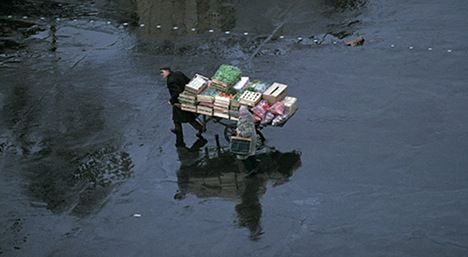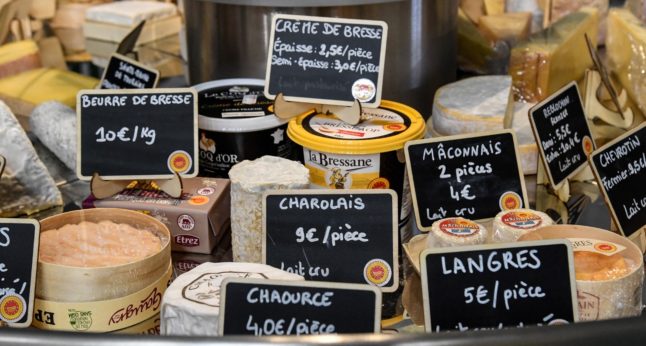Last year the city began an overhaul of the underground mall and suburban railway hub built in its place, the Forum des Halles, which had become a magnet for petty crime and drug trafficking, and a no-go area for locals.
With work now underway on a vast canopy and landscaped gardens that hope to draw back Parisians, more than 200 Doisneau shots capturing the riotous bustle of the market, up until its destruction, went on display at the city hall on Wednesday.
Best known abroad for classic black and white shots such as the iconic picture “The Kiss at the Hotel de Ville”, Doisneau was a tireless chronicler of everyday Parisian life — and Les Halles was a constant subject of fascination.
“There are few subjects that he covered as deeply,” said Doisneau’s daughter Francine Deroudille, who curated the show for the Paris city hall, along with her sister Annette Doisneau.
His first picture of Les Halles was snapped in 1933, a shot of two girls being wheeled backwards on a hand-pulled trolley, outside the vast 19th-century, steel-and-glass market hall known as the Baltard pavilions.
Through the 1940s and 50s Doisneau returned over and over to the market and its larger-than-life characters.
Back then, Paris partygoers would end their night at dawn, exhausted and happy, around a bowl of onion soup at Les Halles, as the ballet of trucks began delivering the day’s market fare.
Flower-sellers, cheesemongers, fishmongers, poultry vendors with their walls of fat geese strung up by the neck, were all given the close-up treatment by the photographer, said Deroudille.
“Those who wanted to get rid of the market cast it as a chaotic mess,” said Deroudille. “But it was extremely well organised, the whole thing running like clockwork.”
Most are vintage shots in black and white, in their original small format, save for half a dozen colour images.
A whole series from the 1950s is devoted to the market’s strong-armed, grinning butchers — with one veteran gazing deadpan into the camera, a knife in one hand and a cow’s head in the other.
Doisneau also shows the population of down-and-outs who would gravitate to Les Halles, curling up to sleep on the sidewalk before renting out their labour at dawn, carrying crates for a few francs.
And he shows the prostitutes, smartly dressed and clutching small handbags, leaning on the walls of Les Halles’ side streets.
A series of images, all taken from the same spot, has well-dressed men and women vaulting over a gutter strewn with market litter, on their way to the office.
Criticising it as unhygienic, outdated and unfit for the needs of a modern metropolis, the authorities under Georges Pompidou — prime minister and from 1969 president of France — called for Les Halles to be razed.
“They took the decision to murder the market,” now seen as a jewel of 19th-century architecture, says Deroudille.
As plans gathered pace for its destruction, overuling the protests of locals, artists and architects, Doisneau started visiting once a week, rising at three in the morning to travel into Paris and bear witness to what he saw as a crime.
“He put his anger into his photographs,” said Deroudille.
In 1969 Doisneau shows traders being moved out of the market, to be rehoused in a purpose-built new complex in Rungis, in the middle of a field south of Paris, which still today acts as the larder of Paris.
Two years later the market hall was destroyed, leaving a gaping hole in the centre of the city, partly, says Deroudille, because it risked becoming a magnet for the counter-culture youths who took to the streets in the May 1968 revolt.
“The whole neighbourhood has been petrified by a brutal frost,” Doisneau wrote at the time. “Paris has lost its belly, and a part of its soul.”
Doisneau shows Parisians peering at architect models for the market site — since no one knew back then what would replace it — and finally, 10 years on, the opening of the Forum des Halles in 1979.
With the future of Les Halles now back on the agenda, Deroudille hopes her father’s work will be used “not to cry over the past — but to think, about the history of a massacre, of a neighbourhood that didn’t work all that badly.”
“The intensely happy, vital, sensual life of Les Halles’ traders, deserves our attention today. They weren’t millionaires, not at all, and yet there is real happiness there.”
Attending the show preview, Paris deputy mayor Anne Hidalgo said the city had drawn the lessons from the past.
“The Baltard pavilions were destroyed in the name of an idea of modernity that wanted to do away with history,” she told reporters.
“The methods were brutal, and Parisians were not consulted one bit. These days we wouldn’t do things that way at all. A city with a gaping hole in the centre just doesn’t work.”
Details of the Doisneau exhibit, which runs at Paris city hall until April 28, are available on www.robert-doisneau.com.



 Please whitelist us to continue reading.
Please whitelist us to continue reading.
Member comments